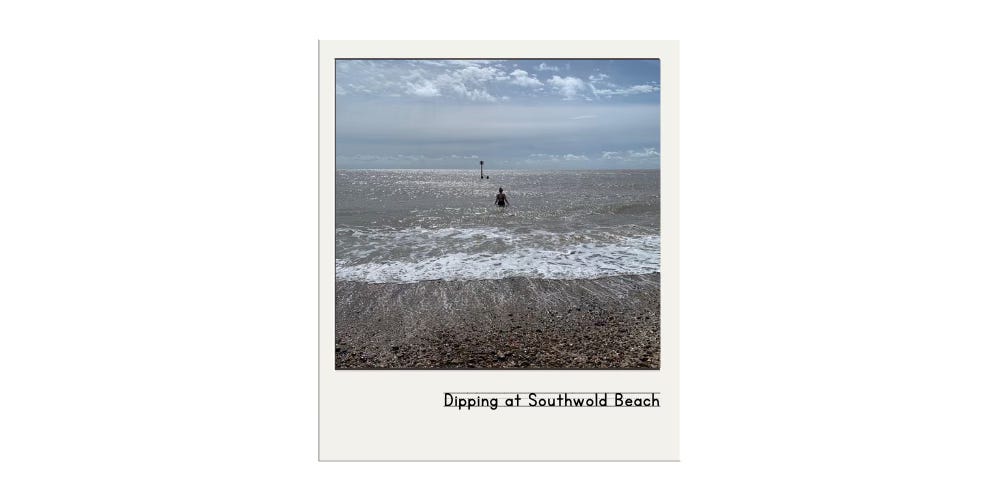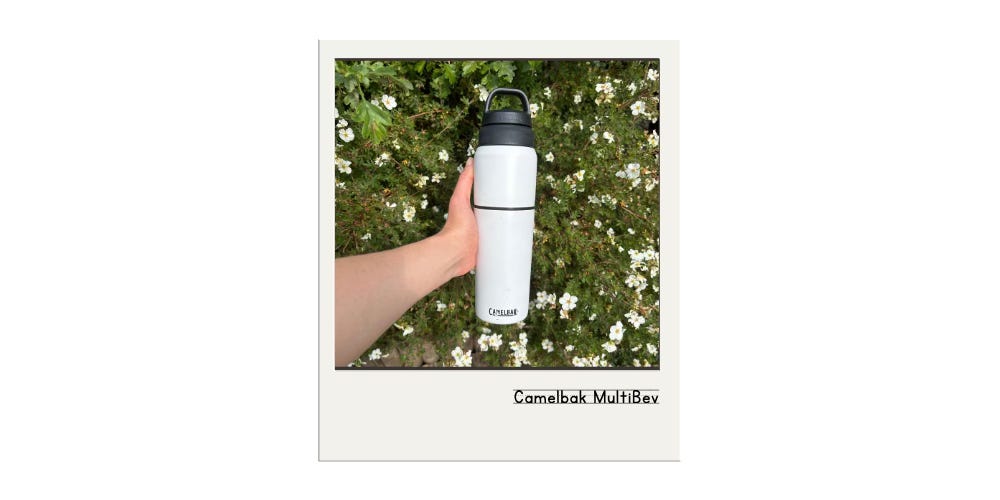The Big Green Internet
Wildlife corridors plus a sea dip and my Camelbak bottle and cup combo
Hello there, I’m Vicky Wren and I run Wren and the Wild - my little side hustle where I use illustration, film, photos and words to explore and protect this wonderful wild world we call home. Subscribe for free to enjoy monthly newsletters and mini in between posts from Edinburgh and the land and water beyond : )
Wild Wanderings
Last month Flo and I travelled down to Suffolk for our nephews’ naming day ceremony and while we were there we had a morning messing about on Southwold Beach. I made sure I packed my cossie and finally had my first wild swim of the year in British waters. It made me feel just as glorious as I knew it would! I cannot believe it’s my first cold dip of the year but I guess better late than never hey?!
I just love plucking up the courage to immerse myself in that chilly water right up to my neck and then stretching out for a good old swim. I always try a bit of jumping up to meet the waves too - a good strategy for trying to stay warm! In the sea I feel that connection to nature in a big way - I am literally immersed in it and by jumping the waves, it’s as if I’m playing a fun game with Mother Nature herself.
Wild Watch
There is an excellent YouTube channel called Leave Curious run by Rob Dymott that I can highly recommend. Dymott is a frustrated ex-environmental consultant who lives in the south of England and creates videos all about rewilding - from tiny wins to huge scale projects. He believes that the natural world desperately needs good communicators and hopes that his content leaves you a little more curious about the natural world than when you found it.
The Leave Curious video that I’m giving a shout out to is called Wildlife Corridors - ‘The Simple Way To Rewild Britain'. Dymott films on an agricultural farm in Essex and hedgerows are in the spotlight because they are a brilliant way of linking up patches of habitat and create a literal corridor for wildlife to travel along. Did you know that if all the hedgerows in the UK were put end to end they would wrap around the world ten times?! However, between 1950 - 2007 we have lost over half of our hedgerows mainly due to landowners being incentivised to do so to grow more food.
He follows Mike Wadham from The Big Green Internet who is spearheading the progress of hedge planting in the UK and the Youngwilders who facilitate small-scale youth-led nature recovery projects across the UK by working with landowners and partner organisations. They plant a hedge to block off an unproductive corner of an agricultural field and then the corner will be given back to nature. Could you imagine if this happened to all the pockets of less productive farmland? Excuse the pun but nature would have a field day!!
Jack Durant, Co-Founder and Co-Director of Youngwilders explains in the video how hedgerows are vital for nature recovery, especially in the south of England:
“…it was the big hitters that got me engrossed originally so just like species re-introduction in big wild spaces, old growth forests…the kind of…enchanting fantasy of wilderness. As we…started working primarily in southern England, especially where the context is very specific and very difficult to do nature recovery work in, you have to learn how to maximise biodiversity and nature recovery in the least disruptive and most realistic ways. And one way that is absolutely phenomenal for nature recovery and that farmers like and is really easy to implement is hedgerows. They’re like the green veins of the countryside. They allow animals to move much more freely through the landscape. They’re fantastic for birds, fantastic for invertebrates, just so so good for all aspects of nature.”
Hedgerows are wildlife heroes! Let’s hope that with the help of people like the Youngwilders we can get back to the number of hedgerows we had before the 1950’s.
Wild Wares
August’s wild ware is my Camelbak MultiBev 2-in-1 stainless steel water bottle and integrated travel cup with lid. I’ve had it for ages and rave about it to anyone that will listen! The water bottle is a decent 500ml size and if you’re walking along and fancy a takeaway tea or coffee you just unscrew the bottom half to access your cup and then unscrew the water bottle lid and out pops your flexible cup lid - genius!
I found that it was tricky to carry around a decent sized water bottle and a coffee cup too on the off chance that you might want a takeaway hot drink that day. Plus, I hated the wastefulness of disposable takeaway cups. So I thought ‘surely a bottle already exists that has a coffee cup as part of the design’ and lo and behold I found the Camelbak ones and haven’t looked back since! I’m chuffed with the amount of takeaway cups I’ve saved from landfill with this handy little fella and would highly recommend one if you have the same space issue/waste anxiety as me!
Wild Win
This month’s wild win is The Big Green Internet - first introduced in the Wild Watch section. This project plants wide wildlife corridors and simple hedgerows to connect isolated ‘orphan’ woodlands together. Their initial focus is Essex (as of April last year they had already planted ten miles of wildlife corridors here) but they plan to take the project across the UK which is just what the wildlife (and the climate) of our beautiful land needs.
The project began by planting a ‘proof of concept’ wildlife corridor which is named ‘The Three Sisters Wood’ and actually exists on the Ordnance Survey online map. (I’ve attempted to draw it above!). This concept is more complex than planting a simple hedgerow. The corridor is ten metres wide and consists of four different layers - mown to rough grass with wildflowers, shrubs and trees.
Mike Wadham from The Big Green Internet talks to Rob Dymott from Leave Curious about the importance of using hedgerows and wildlife corridors to connect patches of woodland within the context of an agricultural farm in Essex:
“At ground level, if you drive around this part or any part of Essex you would think we have a lot of hedgerows and we have a lot of woodlands but if you go up in a drone and look down, one characteristic you’ll see is that we have a lot of woodland…standing there…isolated sitting in a sea of intensive agriculture. So when I was walking around with the farmer here finding a place to put a little woodland in, I said to him…we have enough woodlands here but they’re not talking and they’re slowly dying. Wouldn't it be better if we actually started connecting them all together and create a big green internet of interconnected woodlands.”
Fingers crossed that The Big Green Internet expand out of Essex sooner rather than later and get those hedgerows and wildlife corridors running between woodland patches and filled up with birds, invertebrates and wonderful woodland creatures.
I hope you have a lovely August and I’m already looking forward to catching up with you again with all things wild next month : )
With love and wild hope,
P.S. If you want your Wren and the Wild fill before the September newsletter, you can find me over on Instagram, YouTube and Etsy@wrenandthewild









